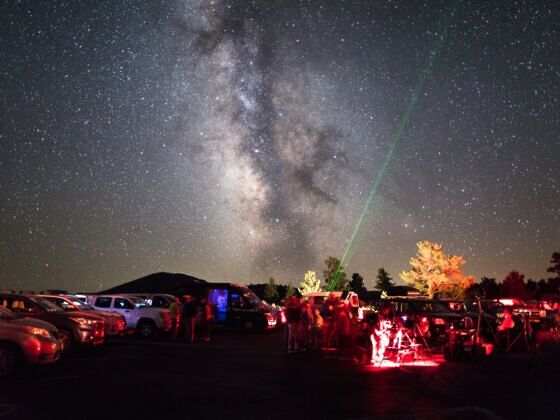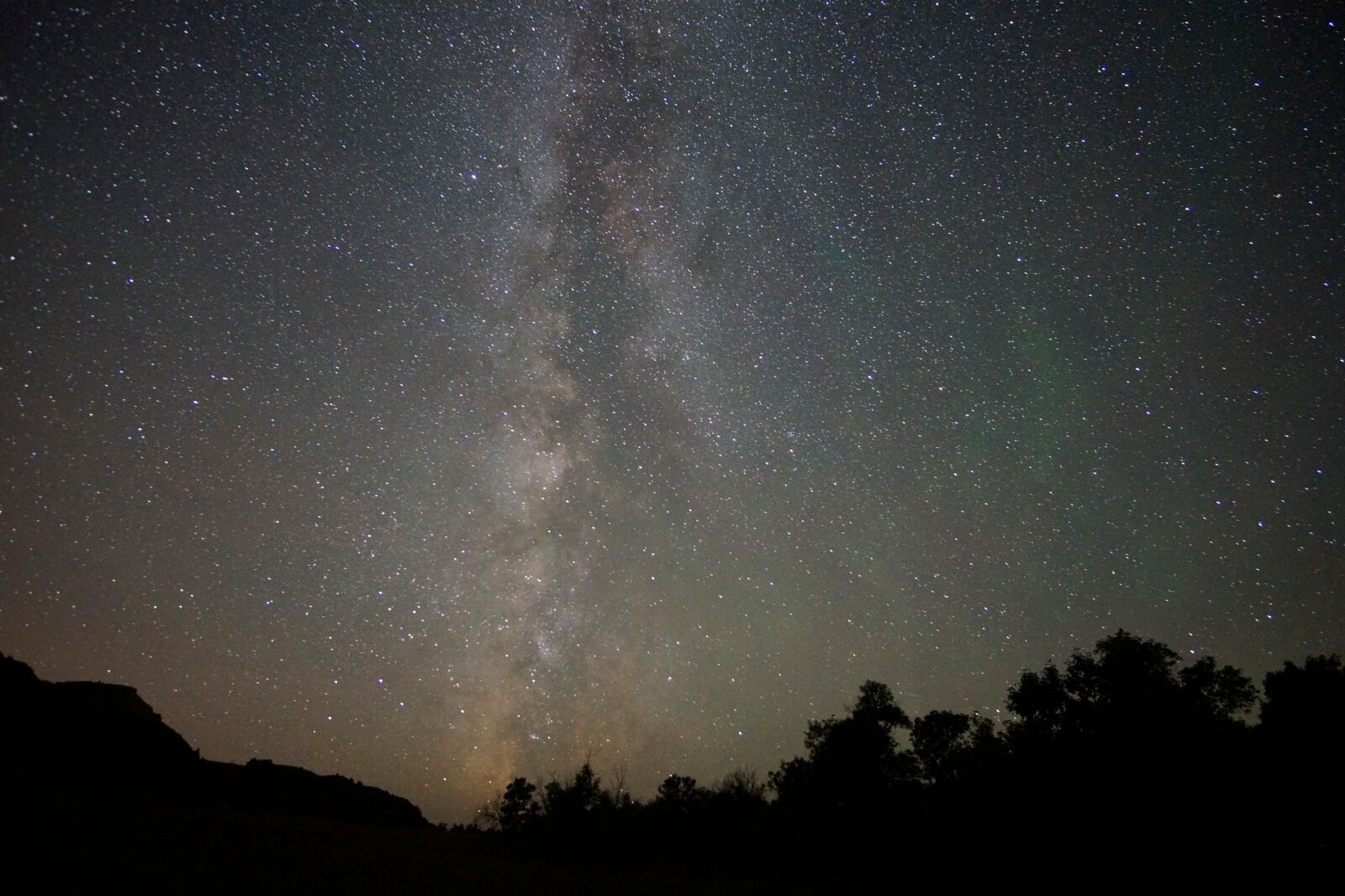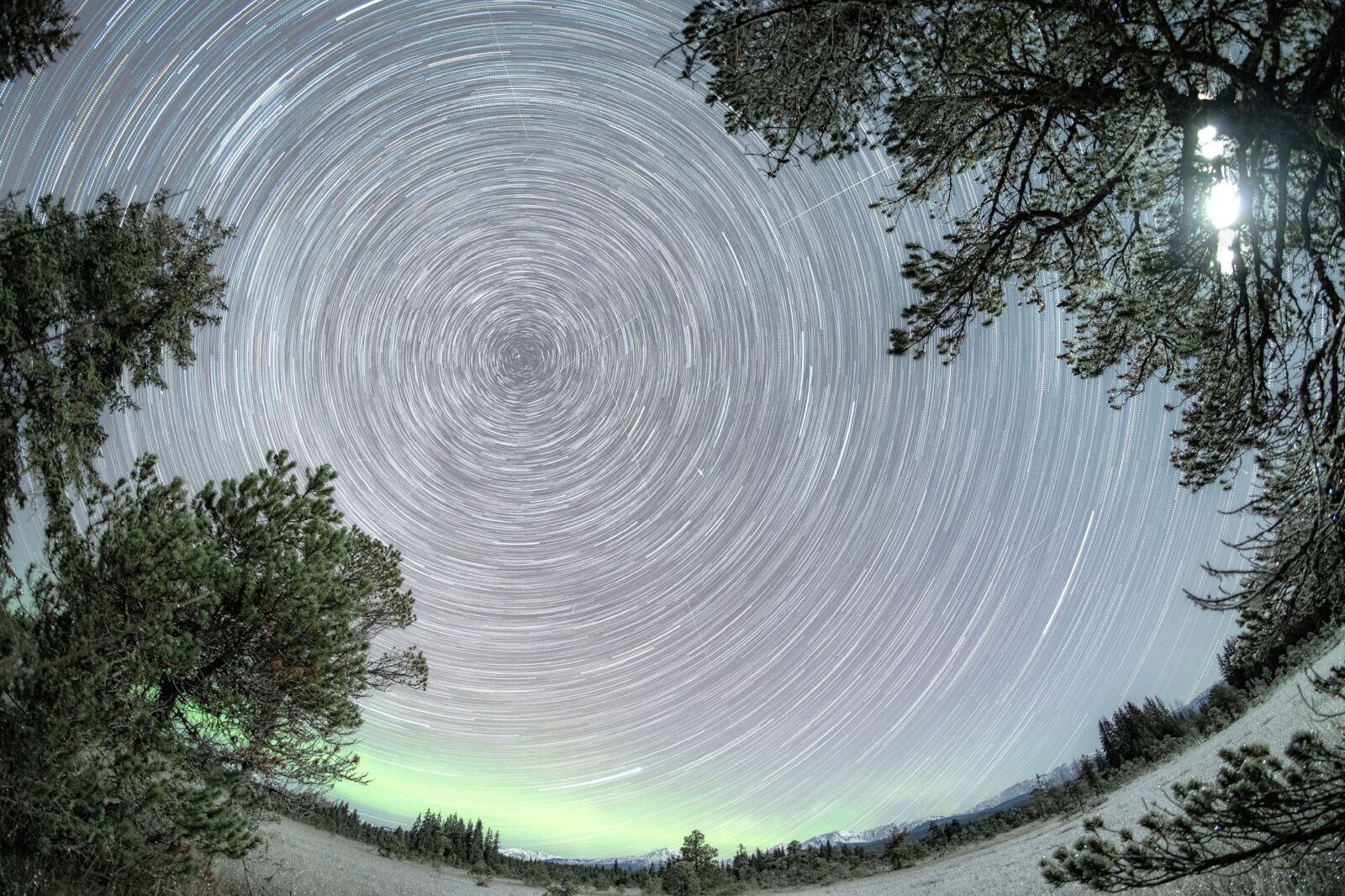National parks are most often experienced during daylight hours. Yet when the sun goes down and the warm sky turns dark, these protected areas turn into a new world and offer some of the most awe-inspiring stargazing opportunities on the planet. Many of the national parks in the United States are far removed from light pollution and have excellent air clarity. Some have been recognized as official International Dark Sky locations. The work the National Park Service has done to protect the night environment is astronomical, and throughout the year, the the parks celebrate this through a robust calendar of events that include star parties, ranger-led astronomy talks, guided stargazing tours, Junior Ranger programs, and festivals.


These National Parks Come Alive at Night With Star Parties and Junior Astronomy Programs
Acadia National Park

Photo: Harry Collins Photography/Shutterstock
Acadia is one of the best dark sky zones in New England, if not the entire Eastern Seaboard. For its proximity to Portland, Boston, and New York, it’s remarkable how luminous the Milky Way presents. If you ask locals, one of the most popular places for stargazing is Cadillac Mountain. Vehicle access to the summit is limited to a choice number of months per year, and between December and April the road is typically closed due to winter conditions. When the route is open, overnight parking is prohibited, and the park closes at 10:00 PM.
Another great place is Sand Beach. Here, you can do your own independent viewing or join park rangers and learn about Acadia’s night sky at free events run between August and September every Sunday and Thursday at 8:30 PM. It’s recommended to dress warmly and bring something comfortable to lie on.
The best spots in Acadia National Park for stargazing
- Cadillac Mountain
- Jordan Pond
- Ocean Path
- Sand Beach
- Schoodic Peninsula
- Seawall
Stargazing at Acadia? Check out Matador’s Acadia National Park accommodations guides:
Arches National Park

Photo: William Pedro/NPS Photo
Arches National Park preserves some of the darkest night sky in the Southwest. Even without the visual aids, you’ll be able to witness a wealth of stars from just about anywhere in the park. If conditions are favorable, you may even be able to view the rings of Saturn through binoculars. It’s recommended to opt for areas away from the main park road and north of Moab. The further you are from vehicle and city light pollution, the better your experience will be.
The National Park Service kindly asks visitors to use red lights and to keep beams directed at the ground and away from arches and other stone formations.
There are various programs within the park, from guided night tours to self-guided explorations. Occasionally, rangers lead formal educational programs during the summer months. These typically run between one to three hours and locations vary.
The best spots in Arches National Park for stargazing
- Balanced Rock Picnic Area
- Garden of Eden Viewpoint
- Panorama Point
- The Windows Section
Stargazing at Arches? Check out Matador’s Arches National Park accommodations guides:
Badlands National Park

Photo: Jeff Zylland/NPS Photo
This national park in South Dakota is one of the top parks in the US for stargazing. On any given night, you can see roughly 7,500 stars. There are a number of reasons for this, but mainly it’s due to its remote location away from urban light pollution. With so much to see, staying overnight in or near park gates is a must. You can also camp in the backcountry if you want an exclusive experience away from crowds.
It’s also one of the top parks for organized experiences. Every night in the spring, summer, and fall, the park rangers hold Night Sky Viewings and talk about what can be seen up above with the aid of powerful laser pointers. It’s also an opportunity to learn how to use the park’s 11-inch Celestron telescopes. Badlands hosts an annual AstroFest, which brings together space science professionals, amateur astronomers, and avid stargazers to celebrate the dark sky. The event runs for three days. Dates and the festival schedule vary and can be confirmed annually at the Ben Reifel Visitor Center.
The best spots in Badlands National Park for stargazing
- Badlands Loop Road
- Big Badlands Overlook
- Panorama Point
- Pinnacles Overlook
Bryce Canyon National Park

Photo: Colin D. Young/Shutterstock
If you’re looking for an educational experience, the team of astronomy rangers and volunteers at Bryce Canyon outshine a lot of other park organizations in the US. Covering subjects such as the life cycles of stars, space exploration missions, and the stories written in the constellations, there are around 100 astronomy programs in the park per year. Some of the most popular are the one- to two-mile full moon hikes. There are two routes available. The more arduous hike descends into the canyon and the other is less strenuous, taking guests along the rim of the plateau. Bryce Canyon has also been in partnership with Utah’s largest group of amateur astronomers, the Salt Lake Astronomical Society (SLAS), who offer their personal telescopes during the annual Astronomy Festival, an event held over four days and includes both daytime and evening programs.
The best spots in Bryce Canyon National Park for stargazing
- Farview Point
- Inspiration Point, Sunset Point, or Sunrise Points
- Mossy Cave Trail
- Natural Bridge Overlook
Stargazing at Bryce Canyon? Check out Matador’s Bryce Canyon National Park accommodations guides:
Canyonlands

Photo: Bettymaya Foott/NPS Photo
Despite being the largest of Utah’s Mighty Five, Canyonlands is often overlooked. And that’s great news for stargazers. It was awarded full status as an International Dark Sky Park in 2015, which was no huge surprise as the dark sky in this area of Utah is world-class. The park does not work alone to protect and educate others about the importance of the night. During spring and fall, rangers often team up with those from Arches National Park and Dead Horse Point State Park and lead visitors through an evening program of stargazing and telescope viewing. There are also events at The Needles and The Maze throughout the year.
The best spots in Canyonlands National Park for stargazing
- Big Spring Canyon Overlook
- Grand View Overlook
- Green River Overlook
- Mesa Arch
- Wooden Shoe Arch Overlook
Stargazing at Canyonlands? Check out Matador’s Canyonlands National Park accommodations guides:
Glacier National Park

Photo: S. Tevebaugh/NPS Photo
Glacier National Park and its neighboring park, Waterton Lakes National Park of Canada, are both certified International Dark Sky Parks. Glacier, located in the northwest corner of Montana, offers visitors a packed calendar of astronomy events and if you get your timing right, you might be able to witness the northern lights.
In collaboration with the Glacier National Park Conservancy, the International Dark Sky Association, the NPS Night Sky Program, and the Big Sky Astronomy Club, there’s a superb range of night-time events and daytime viewing of the sun. After-dark programs are typically held at St. Mary and Apgar and throughout the season — keep an eye out for the Logan Pass Star Parties. To get a taste of what to expect, check out the observatory’s Dusty Star Observatory Sky Cam’s live feed.
The best spots in Glacier National Park for stargazing
- Bowman and Kintla Lakes
- Lake McDonald
- Logan Pass
- St. Mary Observatory
Stargazing at Glacier? Check out Matador’s Glacier National Park accommodations guides:
Grand Canyon National Park

Photo: Jeremy M. White/NPS Photo
The Grand Canyon is undoubtedly one of the world’s most famous landmarks. Formed by a geologic erosion in the desert that showcases different rock layers, the canyon’s sheer size — 277 miles long, up to 18 miles wide, and depths of up to a mile — is staggering. But what people can see up above is equally impressive. Due to the park’s hard work to reduce its light pollution, you can star gaze from practically anywhere in the paek. That said, there’s a great range of organized ranger-led activities.
You might want to plan a visit around the annual Grand Canyon Star Party. Attendance is free if you have paid for a ticket to the park. It begins at sunset, but the show heightens around 9:00 PM. During the event, you can join constellation talks, night sky photography workshops, and presentations at the Bright Angel Point Amphitheater. If you’re visiting outside of the festival, don’t fear. Throughout the viewing season, there are free astronomy programs such as watching the full moon rise over the Canyon, teachings about the mythology, science, and history of the constellations, and educational talks about the Indigenous tribes the of Grand Canyon and their relationship to the night sky.
The best spots in Grand Canyon National Park for stargazing
- Bright Angel Point
- Cape Royal
- Viewpoints near Desert View
- Walhalla Plateau
- Within the Inner Canyon
Stargazing at the Grand Canyon? Check out Matador’s Grand Canyon National Park accommodations guides:
Great Basin National Park

Photo: NPS Photo
Great Basin National Park in Nevada offers an unparalleled stargazing experience. During the summer months, there are free ranger-led stargazing programs. These programs are highly popular and provide an excellent introduction to the night sky. In addition, the park hosts an annual Astronomy Festival in September, which includes telescope viewing sessions, guest speakers, and children’s activities.
If you prefer a more solitary experience, simply bring along a telescope or binoculars. The park’s campgrounds offer fantastic views of the night sky, and you can spend hours gazing at the stars, planets, and galaxies.
The best spots in Great Basin National Park for stargazing
- Baker Archaeological Site
- Mather Overlook on Wheeler Peak Scenic Drive
- Ranch Interpretive Site
Joshua Tree National Park

Photo: Lian Law/NPS Photo
Joshua Tree National Park and the surrounding desert area are some of the best places in California to enjoy the night sky. The whole park is really one gigantic stargazing spot. During spring, fall, and winter, you’ll find a host of ranger-led nighttime activities. These are listed out in the park newspaper that you can pick up on arrival. Camping at Joshua Tree is also recommended. That way you can take in a stargazing session and use what you’ve learned to study the stars from your site. Cottonwood Campground is one of the best camping spots to do this, but it’s often booked up. If so, Jumbo Rocks Campground is another excellent choice. There’s also an annual Night Sky Festival, which is a ticketed event held primarily at Sky’s the Limit Nature Center and Observatory. It is typically held in fall, with tickets available from early summer.
The best spots in Joshua Tree National Park for stargazing
- Arch Rock
- Cap Rock
- Skull Rock
- The Ocotillo Patch
Stargazing at Joshua Tree? Check out Matador’sJoshua Tree National Park accommodations guides:
Mount Rainier National Park

Photo: Tanaka Photography/Shutterstock
Mount Rainier is part of the Cascade Range, an extensive mountain range that stretches from British Columbia in Canada to Northern California. This towering stratovolcano in Washington State offers a breathtaking celestial spectacle.
There are numerous locations that offer clear, unobstructed views of the night sky in Mount Ranier National Park. Paradise, Sunrise, and the Mowich Lake area are particularly advantageous spots for stargazing due to their high elevation and minimal light pollution. Rangers run night skies programs at Paradise between early August and September. Telescope viewings and discussions begin at the plaza outside the Jackson Visitor Center at Paradise at 9:30 PM and typically last for around two hours.
The best spots in Mount Rainier National Park for stargazing
- Frozen Lake via Sourdough Ridge Trail
- Paradise Inn
- Sunrise Visitor Center
Shenandoah National Park

Photo: Mary O’Neill/NPS Photo
Shenandoah National Park, located in Virginia, is one of the most pristine natural environments in the US. The park is characterized by its rugged landscape, with the Blue Ridge Mountains as its backbone. Although Shenandoah does not get as dark as the other parks on the list, its geographical location allows for elevated viewing points and overlooks away from light pollution of nearby towns. It’s also one of the best places in the state of Virginia to see the Milky Way.
The park hosts a Night Sky Festival annually where you can join fellow stargazers at ranger talks, night sky landscape photography classes, kids’ activities, and guest presentations.
The best spots in Shenandoah National Park for stargazing
There are multiple stopping points along the 105-mile Skyline Drive, here are some of the best.
- Indian Run (Milepost 10.5)
- Howwallow Flats (Milepost 13.6)
- Rattlesnake Point (Milepost 21.0)
- Jermeys Run (Milepost 26.5)
- Thorton Hollow (Milepost 27.5)
- Pinnacles (Milepost 35.0)
- Thorofare Mountain (Milepost 40.5)
- Rocky Mount (Milepost 70.1)
- Two Mile Run (Milepost 76.0)
- Rockytop Mountain (Milepost 78.0)
- Doyles River (Milepost 82.0)
- Trayfoot Mountain (Milepost 87.0)
Creating your own national park stargazing adventure
These events aren’t the only time to catch views of the night sky in a national park, of course. If you can’t make a designated event for a guided trip, the National Park Service has a few key tips for those who would like to stargaze on their own.
- Do your research:
- Allow time for your eyes to adjust:
- Pack a red light:
- Use a stargazing app or chart:
Timing is key, and planning around astronomy events is crucial to seeing all there is to see. For one, the moon phase dramatically affects your stargazing experience. Its brightness can impede your ability to see the stars, so viewing on a new moon is recommended. Also check the weather before you venture out, as a cloudless night crucial. Wait an hour or two after sunset, too. This is important to make sure there is no residual light. It’s also worth considering camping overnight. Many national parks have excellent camping facilities for stargazers.
When you’re stargazing, it’s important to allow time for your eyes to adjust to the darkness because it can significantly enhance your ability to see faint objects in the night sky. This is known as dark adaptation. The process can take anywhere from 20 to 30 minutes. During this period, your eyes become more sensitive to light, and you’ll start to see fainter stars and other celestial objects that you wouldn’t be able to see immediately after moving from a bright environment to a dark one. Make sure you don’t force them to readjust right after by looking at your phone, either.
A red light helps to preserve your night vision. Unlike white light, which can be harsh and cause your pupils to constrict, reducing your ability to see in the dark, red light is less intense and does not have this effect. This means you can use a red light to navigate or read charts without compromising your ability to see the stars. Red lights also have a lower impact on wildlife. Many animals are sensitive to white light, which can disrupt their behavior and biological processes. It’s also respectful to other stargazers and the National Park Service who have worked hard to protect the precious dark skies.
If you are stargazing without a guide, stargazing apps and charts will help you navigate the night sky. They can provide detailed information about the objects you’re observing, including names, distances from Earth, history, and associated mythology. Many stargazing apps have a night mode that uses red light to preserve your night vision.